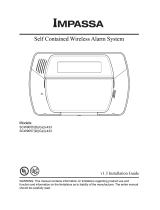
10
FCC Statement
This device complies with Part 15 of the FCC Rules. Operation
is subject to the following two conditions:
(1) This device may not cause harmful interference, and
(2) This device must accept any interference received,
including interference that may cause undesired operation.
FCC Caution:
To assure continued compliance, any changes or modications
not expressly approved by the party responsible for compliance
may void the user’s authority to operate this equipment.
NOTE: This equipment has been tested and found to comply
with the limits for a class B digital device, pursuant to Part
15 of the FCC Rules. These limits are designed to provide
reasonable protection against harmful interference in a
residential installation. This equipment generates uses and
can radiate radio frequency energy and, if not installed and
used in accordance with the instructions, may cause harmful
interference to radio communications. However, there is
no guarantee that interference will not occur in a particular
installation. If this equipment does cause harmful interference
to radio or television reception, which can be determined by
turning the equipment off and on, the user is encouraged
to try to correct the interference by one or more of the
following measures:
- Reorient or relocate the receiving antenna.
- Increase the separation between the equipment
and receiver.
- Connect the equipment into an outlet on a circuit
different from that to which the receiver is connected.
- Consult the dealer or an experienced radio/TV technician
for help.
Requirements for Canada
Department of Communications—
Government of Canada Notice
The Canadian Department of Communications label identies certied equipment.
This certication means that the equipment meets certain telecommunications
network protective, operational and safety requirements. The Department does
not guarantee that the equipment will operate to the user’s satisfaction. Users
should ensure, for their own protection, that the electrical ground connections of
the power utility, telephone lines and internal metallic water pipe system, if present,
are joined together. These precautions may be particularly important in rural areas.
The manufacturer requires that you connect your Communicator to the nationwide
telephone network through a modular telephone jack (USOC RJ11C, RJ11W or
RJ14). This equipment may not be used with coin telephone lines or party lines.
Contact the local public utility commission, public service commission or corporation
commission for information.
Notication for the Telephone Company
Upon request of your local telephone company, you are required to provide them
with the following information:
1. The “Line” to which you will connect your Communicator (that is, your phone
number); and
2. The Communicator’s FCC Registration Number and Ringer Equivalence Number
(REN). Those numbers are on the bottom of your Communicator. The REN is used to
determine how many devices may be connected to a telephone line.
Lifeline 7200C Setup Guide
46 Regulatory Compliance
Excessive RENs on a telephone line may result in the devices not ringing in response
to an incoming call. In most, but not all, areas, the sum of RENs should not exceed
ve (5.0). To be certain of the number of devices that may be connected to a line, as
determined by the total RENs, contact your local telephone company. For
products approved after July 23, 2001, the REN for this product is part of the product
identier that has the format US:AAAEQ##TXXXX. The digits represented by ## are
the REN without a decimal point (e.g., 03 is a REN of 0.3).

















